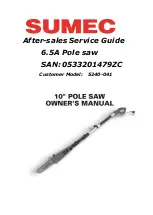
1.
Rotation axle lubrication if the run gets tight
1.1 Loosen the set nut a put a few drops of the lubricant oil
on the washer and the contact area.
1.2 Remove it and lubricate the rotating axle and contact
areas.
NOTICE:
Before removing the axle, the saw disc
top cover and the end stop upper part have to be
removed first. The job should be accomplished by a
skilled servicing technician. Mind the position of both the
spring’s ends in the case. Mark it with a piece of chalk to
facilitate re-installation.
2.
To provide silent and easy run of the swinging
protective cover control lever
, all the metal and plastic
contact areas should be slightly lubricated with sewing
machines oil now and then. Take care not too use
excessive amount of the oil. Sawdust tends to deposit in
the excessive oil and form hard spots.
NOTICE
: „Unplug the machine prior to any adjustment or
maintenance. “
Handling Motor
Caution: To avoid any damage of the motor, clean it
(cooling) of the sawdust and dust regularly.
1.
Connect the saw to the mains of 230V secured with a 16
A fuse and a protective undercurrent switch. Poor
protection may cause a damage to the motor.
2.
If the motor does not start immediately, let the switch go.
UNPLUG .
Check the saw disc for easy run. If it is does run easily,
try restarting again.
3.
When the motor stops sudden while cutting is in
progress, push the switch off and unplug the machine.
Release the saw disc from the material cut. Afterwards,
you may finish the job. .
4.
Fuses or protection switches may respond to conditions
as follows:
a.
THE MOTOR IS OVERLOADED. If the saw
disc is immersed in the material too fast or if the
saw is switched on and off too often, it may
result in the motor overloading or a fault on the
gear.
b.
Fluctuations of the mains voltage within a range
of
10% will not pose any risk to normal
operation of the saw. However, if the load is too
high, the voltage on the motor connection
terminals should correspond to the plate data.
5.
Many problems of the motor may be caused by loosen
or defective connectors, overloading, undervoltage (the
latter may result from too small cross-section of supply
cables). Always check all the connections, voltage value
and the current consumed.
14















































